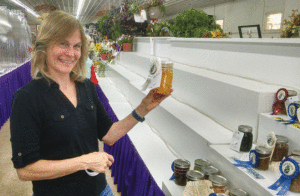
Standing in front of shelves soon to be filled with floral arrangement entries, Jane Radnor, a certified Food Preservation judge and self-described canning addict, used her peaches submission for this year’s Howard County Fair to discuss the finer points of competitive canning submissions. (Photo by Joan M. Kasura)
With Labor Day coming relatively early this year, thoughts have quickly moved from care-free summer fun to back-to-school nights, pumpkin spice lattes, and fall harvest festivals.
For some, Labor Day may even signal the imminent closing of your local farmers’ market — though most listed on Maryland Farmers Market Directory have closing dates stretching into October, or beyond and a hardy baker’s dozen indicate they are open year around.
That means a lot of local food will still be available to preserve for the coming winter months.
You may also be one of those gardeners who, by this time of year, are swimming in an excess of zucchini squash, tomatoes and cucumbers.
What does one do with all that excess? Freeze it? Perhaps.
Freezing, while an easy way to quickly put up those overflowing extras, can present problems “for those who have limited frozen space available, or if you live in a really rural area with unpredictable electricity,” said Jane Radnor, a certified food preservation judge and self-described canning addict.
Instead, Radnor advocates for the many advantages of canning.
“It’s something easy to put on the shelf and not worry about it,” she said.
Thanks partially to the burgeoning sustainable homesteading movement, canning is continuing in its recent comeback.
One of the more recent comprehensive book additions to the food preservation movement comes from Washington state’s Ann Accetta-Scott, a homesteader and blogger of “A Farm Girl in the Making.”
Published at the beginning of May, Accetta-Scott’s book provides a readable guide full of tips, charts and checklists to different aspects of food preservation, including chapters covering water canning and pressure canning.
Along with the USDA’s Complete Guide to Home Canning, which can be downloaded as free from the agency’s website, and the multitude of resources found on the website of the National Center for Food Preservation, including their 6th edition of So Easy to Preserve, many do-it-yourself canners will have a good grounding in “current research-based recommendations for most methods of home food preservation.”
Sometimes, though, taking an in-person class provides that additional level of confidence needed to head into your own kitchen.
“It’s similar to when you try to learn a new recipe. Sometimes you can watch all the YouTube videos you want, and still not feel comfortable with what you’re doing,” explained Dr. Shauna Henley, University of Maryland Family & Consumer Sciences Extension agent in Baltimore County. “Taking an in-person class helps gives you some familiarity with canning knowledge as well as help in using the equipment appropriately.
“It gives you a safe place to mess up versus trying to can something at home and have 9 jars going bad on your pantry shelf.”
She noted that in-person hands-on classes are especially helpful for those interested in learning pressure canning, which is the required method of canning for low acid foods — that is, foods with a pH value higher than 4.6 such as meats, seafood, poultry, milk, and all fresh vegetables, except for most tomatoes.
Whether or not you elect to do a class, both Henley and Radnor stress that the key to good canning results begins with the ingredients.
That means finding fresh produce at its peak and processing it within 24 to 48 hours of acquiring it.
And, if you’re not canning yours or your neighbor’s excess, the next best option is your local farm or farmers’ market.
When Radnor begins her canning for the many fairs she exhibits at each summer, she usually heads to a local pick-your-own farm for her ingredients.
Henley works directly with Wendy Dilworth, a fifth generation member of Hills Forest Fruit Farm, which is run by her brother Richard Dilworth and her nephew Patrick, to plot out each year’s canning classes, beginning with stalks of asparagus in April — which Henley used this year to teach her first pressure canning workshop of the season.
“If you know your (farmers’ market) vendor, and they know you need a large quantity of something, most farmers will work with you,” Dilworth said.
As an example, Henley pointed to two recent workshops she taught on peaches.
The second workshop, which was a peach salsa recipe, required a much firmer texture for the fruit than the first workshop, which simply involved straight canning of the peaches.
“If you let your farmer know ahead of time that you need that firmer fruit,” Dilworth continued, “then they can set it aside for you. Of course, the best part of that is you don’t have to get up early on a weekend morning.”




